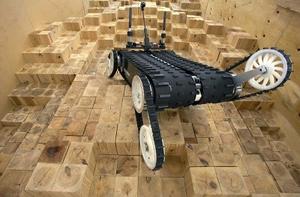Japanese rescue robot can sniff out, and help, buried disaster survivors
Japanese emergency services are testing a search-and-rescue robot that can search rubble for survivors and deliver water, food, or cellphones in disaster zones; the device has a robotic arm that can be remote-controlled to turn doorknobs, maneuver through rubble and carry crucial survival items after an earthquake or other disaster

QUINCE can handle most any obstacles, and is capable of opening doors, delivering food, water and cell phones // Source: robotshop.com
Japanese emergency services are testing a small tank-like rescue robot that can search rubble for survivors and deliver water, food, or cellphones in disaster zones.
The fire department of Chiba City, east of Tokyo, will test the QUINCE prototype from next month, said Eiji Koyanagi, robotic engineering expert at Chiba Institute of Technology.
“People die because they despair. If the robot delivers a cellphone, they won’t feel alone. If the robot delivers water and food, they can hold out,” said Koyanagi. “We want to make this the world standard.”
AFP reports that the QUINCE, the size of a toddler’s play car, has a robotic arm that can be remote-controlled to turn doorknobs, maneuver through rubble and carry crucial survival items after an earthquake or other disaster. Human rescuers manipulate the arm from afar using a computer link that shows them robo-view camera images.
The machine also features infrared and carbon-dioxide sensors to find survivors by detecting their body heat and their exhaled breath, and creates three-dimensional maps of the site as it crawls.
Four sets of wheels, each driving a tank-like rubber track and powered by a total of six electric motors, enable the machine to push ahead over bumps and up and down slopes as steep as 82 degrees.
People trapped under rubble can also hear the voices of rescuers through a speaker fitted to the robot.
Koyanagi, speaking at Tokyo’s Robotech fair, said it is essential for the robot to be tested by real rescuers to improve and “fine-tune” its design.
Engineers may develop the wrong ideas, he said: in the past, “we made touch panels… only to find rescuers wear gloves and can’t use them.”
Japan is prone to earthquakes, with about 20 percent of the world’s most powerful tremors striking the island nation.
